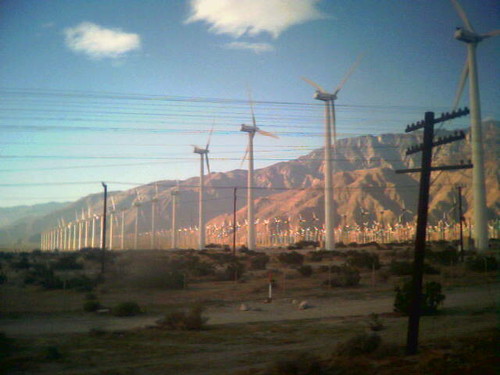Can You Feel Which Way The Wind Is Blowing ?
Posted by Big Gav in wind power
AP reports that T Boone Pickens' wind power project has bought 667 GE wind turbines.
A renewable energy company founded by billionaire T. Boone Pickens has placed an order for 667 wind turbines from General Electric Co. as part of a $2 billion start-up of what is slated to become the world's largest wind farm. The longtime Dallas oilman said the total cost is likely to rise considerably as three additional phases of the project come online.
Mesa plans to install the turbines in the Texas Panhandle, a sparsely populated region that the company said is a "logical location" for wind-generated power. Electricity produced by the turbines is expected to come online by early 2011. The turbines can each produce 1.5 megawatts of electricity. That makes the project's first phase capable of producing a total of 1,000 megawatts, or enough energy to power more than 300,000 average U.S. homes, the company said.
Wind in the area of what will be called the Pampa Wind Project often blows during the middle of the day, when demand for electricity peaks, the company said. Matching power production with demand is essential because electricity is difficult to store on a large scale.
Pickens, who was born in nearby Oklahoma and made the early part of his fortune hunting for oil and natural gas, said that developing alternative energy projects is critical for the nation's future. "You find an oilfield, it peaks and starts declining, and you've got to find another one to replace it," Pickens said in a statement. "With wind, there's no decline curve."
The entire four-phase project is forecast for completion in 2014. It will eventually have 4,000 megawatts of capacity.
At Salon, Joe Romm is listening for the Winds of change - "The U.S. can greatly boost clean wind power for 2 cents a day. Now all we need is a president who won't blow the chance".
A stunning new report just issued by the Bush administration finds that for under 2 cents a day per household, Americans could get 300 gigawatts of wind by 2030. That would:
# Reduce carbon dioxide emissions from electricity generation by 25 percent in 2030.
# Reduce natural gas use by 11 percent.
# Reduce cumulative water consumption associated with electricity generation by 4 trillion gallons by 2030.
# Support roughly 500,000 jobs in the U.S.
The report doesn't mention that this would require adopting policies the Bush administration opposes. But that's what elections are for.
Wind power is coming of age. In 2007, some 20,000 megawatts of wind were installed globally, enough to power 6 million homes. Sadly, most wind power manufacturers are no longer American, thanks to decades of funding cuts by conservatives. Still, new wind is poised to be a bigger contributor to U.S. (and global) electricity generation than new nuclear power in the coming decades. As I have written earlier, concentrated solar power could be an even bigger power source, and it can even share power lines with wind.
That means we can realistically envision an electric grid built around renewables: electricity with no greenhouse gas emissions, no fuel cost (and no future price volatility) and no radioactive waste. But while it is poised to happen, and other governments are working hard to claim market share, America will need a bold president to ensure leadership in these major job-creating industries of the 21st century.
Like solar thermal, wind energy has a long history. More than 2,000 years ago, simple windmills were used in China to pump water and in Persia and the Middle East to grind grain. Merchants and returning veterans of the Crusades introduced windmills to Europe in the 11th century, where first the Dutch and then the English improved the design. By the 18th century, more than 10,000 windmills operated in the Netherlands, where they were used to grind grain, pump water and saw wood. Ultimately the mills were replaced by steam engines because they could not compete with the low cost, convenience and reliability of fossil fuels. In America, windmills were widely used in the West by the end of the 1800s, providing water for irrigation and electricity for isolated farmers.
While wind has not been able to compete with large central-station electric power plants for most of this century, it began to see a resurgence in the 1970s because of the energy crises and government support. Those wind turbines, however, were crude derivatives from airplane propellers and were noisy and inefficient. Over the past quarter-century, significant aerodynamic improvements in blade design have largely solved both problems and brought down the cost of electricity from wind power by 10 percent a year (until recently). Wind energy can now be captured efficiently over a broad range of wind speeds and direction. Turbines, now placed where the wind is constant, have been scaled up from 35 kilowatt models of the early 1980s to 2 megawatts (2,000 kilowatts). Better weather forecasting and computer modeling allow much more confident predictions of wind availability 24 hours ahead of time.






